The 5 Rules I Use To Justify Whether Or Not I Can Make A Purchase

As someone who flinches every time she buys something “expensive,” it has been a bit of a journey to fully appreciate the wisdom of shopping for quality. Concepts like “value for money” or “cost per wear” have gradually become part of the lexicon and thought process. It is still difficult to resist grabbing the items with the biggest price difference during sales, but I’ve started to adopt a more mindful spending pattern guided by a few valuable principles gained over the years.
1. The Tipping Point
As a young adult, I’ve started to value quality over quantity, and this applies to everything from my grocery shopping to skincare, makeup and clothes. While there are a few outstanding gems that are fantastic quality for cheap, pricey items do tend to be better quality. However, there is a tipping point.
When I think about brands like Tiffany, La Mer, and SKII, I am acutely aware that much of the inflated price-tag comes from branding. While the products are lovely and do work, I am uncomfortable paying for a premium just because of the brand name. Thankfully, with the internet being a wonderful place to share information, there are always alternative options that are similar quality for a lower price point. Of course, the ultimate hack would be to get luxury items for cheap. For instance, scoring designer brands at Goodwill, or getting an amazing deal around Black Friday.
2. What makes the Product?
To avoid the Tipping Point, I pay careful attention to the ingredients list. This helps me take a step back from the marketing hype and to see if I’m actually getting what I’m paying for. Likewise, for clothes, I look at the actual mix of material that goes into the item (100% cotton? 100% silk? Polyester Blend?). Some of my sweaters from H&M have lasted me for years and are extremely warm, thanks to the fact that they’re wool.
3. Who makes the Product?
Did you know that L’Oreal owns Lancôme, Giorgio Armani, Kiehl’s, IT Cosmetics, and Urban Decay? When buying a L’Oreal serum at the drugstore, I think about the fact that L’Oreal has the multitude of laboratories that makes all of these brands at its disposal.
Chanel and Bourjois are sister brands (note: COTY bought the brand from Chanel in 2015), and it is no coincidence that the Bourjois Healthy Mix Serum Foundation and the Chanel Vitalumiere Aqua Foundation are known to be dupes. Similarly, Nip + Fab is the “drugstore” version of Rodial Skincare. It pays to know who makes your products — you could be getting essentially the same thing for much cheaper!
4. “Expensive” is Subjective
What constitutes “expensive” is subjective. Not because once you have a higher disposable income, everything becomes less expensive, but because you start to put a premium on the value of your time.
Therefore, spending one hour to hunt down the cheapest place to buy a certain item no longer makes sense if that same hour can be better spent earning the difference that you might have saved, or more. As a student, I could afford to hunt down the best bargains, stay up late for a sale to start, and pounce on limited items. As a working adult, such actions become less feasible as my opportunity cost increases.
Most of the time, I try to find a compromise. For specific high-value items, I do try to get them on big sale days like Black Friday or Cyber Monday. I try to organize an informal “group buy” among friends and family. We take turns for each person to be in charge of purchasing, and let the person know in advance the items we want. It is also much easier to meet the minimum shipping requirements this way. How many times have you added something to your basket that you don’t really need just to make the minimum for free shipping?
5. Cheap, Fast, Good
(1) Cheap (2) Fast (3) Good
My boss used to tell me that a service can only be two out of three things. For instance, cheap and good (but takes time) or fast and good (but expensive). (She was irritated that upper management wanted us to be all three — a herculean task.) I’ve found that this is a pretty accurate statement for almost all goods and services.
If you want something fast and good, be prepared to fork out a little more money. Everyone has different priorities, and our spending patterns should reflect them. How and what I want to get out of a purchase may be very different from what others want or get. Case in point, lattes. They may be an absolute waste of money for some, but a priceless pick-me-up for others. So, shopping mindfully doesn’t always mean finding the cheapest item. I find that being conscious of why I choose to buy something gives me peace of mind and holds me accountable for my purchases.
Ally G. updates her beauty blog regularly with product reviews and recommendations. She spends an abnormal amount of time browsing cat memes on the internet and channels the rest of her creative energy in writing dystopian fiction available on Amazon.
Image via Unsplash




